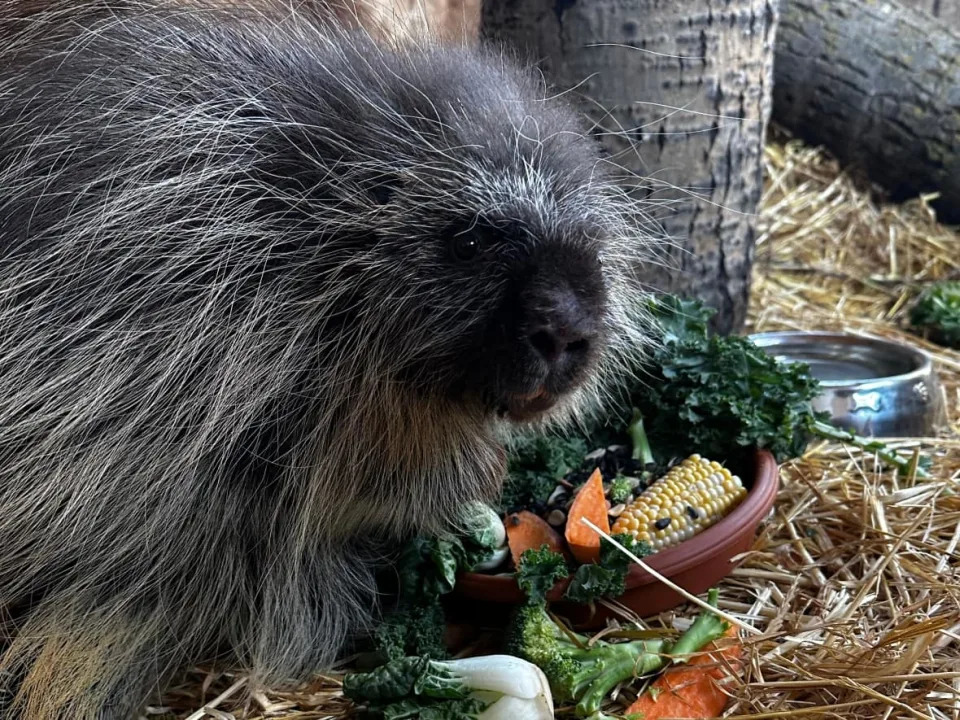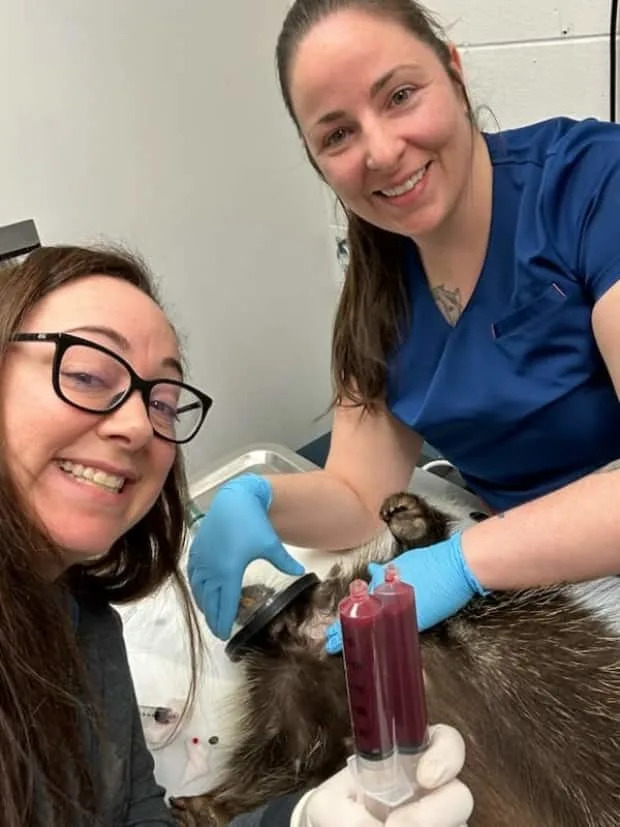That's one prickly situation
CBC
Sun, April 9, 2023

Since receiving a blood transfusion last month, this porcupine is healthy and eating a whole buffet of fruits and vegetables. (Submitted by Carly Lynch - image credit)
An Edmonton vet last month successfully performed a rare blood transfusion, giving an ailing porcupine a new lease on life.
Dr. Darren Mandrusiak works at the Harvest Pointe Animal Hospital, an exotic pet hospital in the southeast of the city, and volunteers with WildNorth, an animal rescue and rehabilitation organization.
"The porcupine actually had a really severe infestation of bloodsucking lice, to the point where it had lost enough blood that it was quite ill," he told CBC's Edmonton AM.
At the time, WildNorth had two porcupines in its care.
The first, smaller animal, was being treated for parasites that had caused anemia and respiratory infection. It wasn't eating, and was very lethargic.
The second, much larger, porcupine had been brought in after being attacked by a dog. It had recovered from severe injuries and was healthy, strong and feisty.
The vet and his team considered multiple treatments for the sick porcupine but none of them helped.
"That was when we decided the only other option we have is to try a blood transfusion to see if we can get its red blood cells up," Mandrusiak said.

Submitted by Carly Lynch
The goal was to get the sick animal moving and eating again.
"We decided because the healthy porcupine was actually so much bigger than the little porcupine that needed the blood transfusion that the risk would be minimal to the donor," Mandrusiak said.
But having never done a blood transfusion on a wild animal before, Mandrusiak was nervous. And the team didn't know if the donor would be a match for the porcupine.
Blood transfusions are quite common for dogs and cats. Most emergency veterinary hospitals and critical-care facilities have access to the Canadian animal blood bank.
There is no blood bank for wild animals, Mandrusiak said, so fresh blood has to be collected from a donor. It was a coincidence that two porcupines were receiving care at the same facility, he said.
"We didn't know we were going to be able to get enough blood. We didn't know that we were going to be able to keep the porcupine quiet enough to keep an IV catheter inside the whole time," he said.
He and his team worked swiftly to sedate the donor animal and were able to collect about 80 millilitres of blood. They performed the transfusion on March 2.
Carly Lynch, the director of WildNorth's rehab centre, said the shelter often sees porcupines coming in, but has previously been involved in a porcupine blood transfusion.
"I know a lot of people would think it's just a porcupine, why bother?" she said.
"She was suffering. It's about compassionate care for those individuals and not necessarily only dealing with endangered or listed species."
Porcupines are native to Edmonton's ecosystem and next to the beaver are the second largest rodent species in North America.
As tree pruners, they eat barks and parasites off of trees and also are an important prey animal for others.
The donor porcupine was released into the wild on March 27.
The smaller porcupine is healing at WildNorth's rehab centre, gaining weight and eating a whole buffet of fruits and vegetables, Lynch said.
Mandrusiak and his team are currently writing about the procedure for publication in a wildlife veterinary medicine journal.
CBC
Sun, April 9, 2023

Since receiving a blood transfusion last month, this porcupine is healthy and eating a whole buffet of fruits and vegetables. (Submitted by Carly Lynch - image credit)
An Edmonton vet last month successfully performed a rare blood transfusion, giving an ailing porcupine a new lease on life.
Dr. Darren Mandrusiak works at the Harvest Pointe Animal Hospital, an exotic pet hospital in the southeast of the city, and volunteers with WildNorth, an animal rescue and rehabilitation organization.
"The porcupine actually had a really severe infestation of bloodsucking lice, to the point where it had lost enough blood that it was quite ill," he told CBC's Edmonton AM.
At the time, WildNorth had two porcupines in its care.
The first, smaller animal, was being treated for parasites that had caused anemia and respiratory infection. It wasn't eating, and was very lethargic.
The second, much larger, porcupine had been brought in after being attacked by a dog. It had recovered from severe injuries and was healthy, strong and feisty.
The vet and his team considered multiple treatments for the sick porcupine but none of them helped.
"That was when we decided the only other option we have is to try a blood transfusion to see if we can get its red blood cells up," Mandrusiak said.

Submitted by Carly Lynch
The goal was to get the sick animal moving and eating again.
"We decided because the healthy porcupine was actually so much bigger than the little porcupine that needed the blood transfusion that the risk would be minimal to the donor," Mandrusiak said.
But having never done a blood transfusion on a wild animal before, Mandrusiak was nervous. And the team didn't know if the donor would be a match for the porcupine.
Blood transfusions are quite common for dogs and cats. Most emergency veterinary hospitals and critical-care facilities have access to the Canadian animal blood bank.
There is no blood bank for wild animals, Mandrusiak said, so fresh blood has to be collected from a donor. It was a coincidence that two porcupines were receiving care at the same facility, he said.
"We didn't know we were going to be able to get enough blood. We didn't know that we were going to be able to keep the porcupine quiet enough to keep an IV catheter inside the whole time," he said.
He and his team worked swiftly to sedate the donor animal and were able to collect about 80 millilitres of blood. They performed the transfusion on March 2.
Carly Lynch, the director of WildNorth's rehab centre, said the shelter often sees porcupines coming in, but has previously been involved in a porcupine blood transfusion.
"I know a lot of people would think it's just a porcupine, why bother?" she said.
"She was suffering. It's about compassionate care for those individuals and not necessarily only dealing with endangered or listed species."
Porcupines are native to Edmonton's ecosystem and next to the beaver are the second largest rodent species in North America.
As tree pruners, they eat barks and parasites off of trees and also are an important prey animal for others.
The donor porcupine was released into the wild on March 27.
The smaller porcupine is healing at WildNorth's rehab centre, gaining weight and eating a whole buffet of fruits and vegetables, Lynch said.
Mandrusiak and his team are currently writing about the procedure for publication in a wildlife veterinary medicine journal.
No comments:
Post a Comment